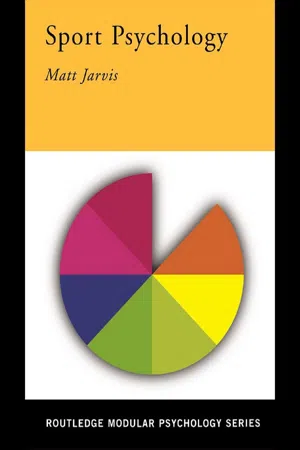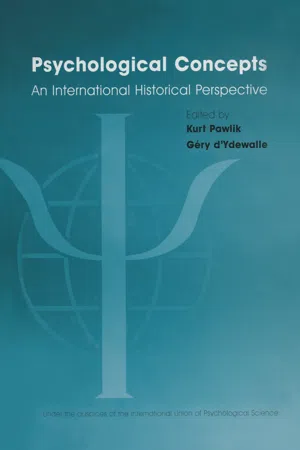Psychology
The Gilchrist and Nesberg study of motivation
The Gilchrist and Nesberg study of motivation explored the impact of intrinsic and extrinsic motivation on task performance. They found that intrinsic motivation, driven by internal factors such as personal interest and enjoyment, led to higher quality performance and greater persistence compared to extrinsic motivation, which is driven by external rewards or pressures. This study highlighted the importance of intrinsic motivation in fostering optimal task engagement and performance.
Written by Perlego with AI-assistance
Related key terms
Related key terms
1 of 4
Related key terms
1 of 3
7 Key excerpts on "The Gilchrist and Nesberg study of motivation"
- eBook - ePub
- Matt Jarvis(Author)
- 2006(Publication Date)
- Routledge(Publisher)
8 Motivation and sport
By the end of this chapter, you should be able to:Learning objectives- appreciate the distinction between intrinsic and extrinsic motivation and discuss the usefulness of the additive principle
- describe and evaluate Maslow’s hierarchy of needs as an explanation of sporting motivation
- understand the importance of achievement motivation, with particular reference to Nicholls’ theory of achievement orientations
- outline attribution theory with particular reference to the work of Bernard Weiner, and assess the usefulness of attribution therapy
- discuss self-efficacy as a factor in sporting motivation
- explain the phenomenon of counterfactual thinking and explain its importance in sport
- consider that there may be pathological aspects of motivation for sport.
One of the fundamental questions about human nature that psychologists need to answer is, ‘Why do we do things?’ We could simply answer, ‘because I want to’, ‘because I need to’, or even ‘because I just do’. However, although all these statements are useful starting points, psychologists are not satisfied with these answers, and seek to uncover the reasons underlying our experiences of wanting to, needing to or ‘just doing’ things. In this chapter, we can examine some basic types of human motivation, theories about specific motivators and research findings concerning what motivates us to participate and succeed in sport. A useful starting point is to examine intrinsic and extrinsic motivation.Intrinsic and extrinsic motivation
An important distinction in types of human motives is that between extrinsic and intrinsic motivation. Extrinsic motivation results from external rewards. Intrinsic motivation comes from within the person. Both extrinsic and intrinsic motives are important in sport, and sport psychologists can work with both extrinsic and intrinsic motives to improve the performance of the individual. Intrinsic motives for taking part in sport include excitement, fun, love of action and the chance to demonstrate and improve our skills – in short, all the reasons that we enjoy - eBook - ePub
- Matt Jarvis(Author)
- 2005(Publication Date)
- Routledge(Publisher)
7 Motivation and sport Intrinsic and extrinsic motivation Humanistic perspectives on motivation Achievement-motivation Cognitive approaches to motivation Contemporary research on motives for sports participation SummaryOne of the fundamental questions psychologists need to address about human nature is ‘Why do we do things?’ We could simply answer ‘Because I want to’, ‘Because I need to’ or even ‘Because I just do’. However, although all these statements are useful starting points, psychologists are not satisfied with these answers and seek to uncover the reasons underlying our experiences of wanting to, needing to or ‘just doing’ things. In this chapter, we will examine some basic types of human motivation, theories about specific motivators and research findings concerning what motivates us to participate and succeed in sport. A useful starting point is to examine intrinsic and extrinsic motivation.Intrinsic and extrinsic motivation
An important distinction in types of human motives is between extrinsic and intrinsic motivation. Extrinsic motivation results from external rewards; intrinsic motivation comes from within the person. Both external and intrinsic motives are important in sport and sport psychologists can work with both extrinsic and intrinsic motives to improve the performance of the individual. Intrinsic motives for taking part in sport include excitement, fun, love of action and the chance to demonstrate and improve our skills—in short, all the reasons we enjoy sport. Later in this chapter we will discuss some techniques designed to increase intrinsic motivation. The reason these can be used so effectively to motivate athletes is that they directly affect our intrinsic motivation. Extrinsic motives can come in the form of trophies, prizes and less tangible rewards such as praise and status.Generally, we tend to come to sport motivated more by intrinsic than extrinsic factors. However, extrinsic motivators have been used in an attempt to boost intrinsic motivation. The additive principle states that an athlete low in intrinsic motivation can have their motivation boosted by adding some extrinsic motivation. This common-sense approach has, however, not been well supported by research. There are numerous case studies of athletes whose performance has sharply declined as soon as they have received lucrative contracts (Cox 1998). Intensive, stressful competition may also reduce intrinsic motivation. Fortier et al. - eBook - ePub
Psychological Concepts
An International Historical Perspective
- Kurt Pawlik, Gery d'Ydewalle(Authors)
- 2020(Publication Date)
- Psychology Press(Publisher)
A good example of a motivational theory that is neither a really global or holistic approach to motivation, nor a very limited theory such as the theory of achievement motivation, is the distinction made between intrinsic and extrinsic motivation. Since the 1970s, and until quite recently, much research was devoted to these two distinct categories or types of motivation. An action is intrinsically motivated when it is autotelic, the goal is the action itself. Good examples are curiosity or the need for knowledge, the need for competence and the need for autonomy. People can be intrinsically interested in gaining knowledge, in feeling competent, and in being autonomous or self-regulating. Intrinsically motivated activities are not instrumental, the satisfaction is inherently associated with the activity as such (e.g. to learn about or get more insight into something; to play tennis for the fun of it). An activity is extrinsically motivated when it is instrumental for reaching a goal that is not inherently related to that action (e.g. to study in order to get a reward; to play tennis to become a pro and make a lot of money).Motivational research in educational psychology is mostly limited to intrinsic motivation (Pintrich & Schunk, 2002), whereas theories about work motivation are more often about extrinsic motivation (Pinder, 1998). It is, however, quite evident that many activities are both intrinsically and extrinsically motivated. Students study hard because they are thrilled by insight into and understanding of a particular phenomenon (e.g. human motivation) but also because they are motivated to succeed in the exams following the course on motivation. Employees, as well as their employers, are motivated for their job by financial incentives in order to make a living for themselves and their families, but very often also because they like to feel competent and be efficient at their job. This implies that the total motivation for many of our daily activities must be conceived of as the sum of an intrinsic and an extrinsic component. The strength of the total motivation to study, to work, and so on can hence be increased by intensifying the intrinsic or the extrinsic component, or both. This does not, however, imply that the two types of motivation are always additive. The title of Lepper and Greene’s 1978 book The hidden costs of reward - Christine M. Rubie-Davies(Author)
- 2010(Publication Date)
- Routledge(Publisher)
These three elements are in a number of definitions of motivation. For example, Franken (1988) described motivation as concerned with the ‘arousal, direction and, persistence of behaviour’, while Bandura defines it as a multidimensional phenomenon that controls the ‘selection, activation and sustained direction of behaviour’ (1991: 158). In the context of achievement motivation, Stipek notes that theorists attempt to explain the ‘initiation, direction and intensity of an individual’s behaviour’ (1988: 9).Although there is some relative agreement that motivation refers to a force that impels us toward a chosen goal, it is easy to be overwhelmed by the variety of motivational theories. Some understanding of the range and variety of theoretical subconstructs that underlie motivation can be seen in Ford’s (1992) summary of 32 different theories of motivation. Motivation has been studied from a number of major theoretical perspectives, including psychoanalytic theory, need or drive theories, operant learning theory, humanistic theory, social learning theory, cognitive theory and, more recently, sociocultural theory. Readers will also likely be familiar with expectancy value theory, field theory, cognitive dissonance theory, causal attribution theory, personal causation theory, learned helplessness theory, self-worth theory, self-determination theory, self-efficacy theory, goal-setting theory, and goal orientation theory. This list, while not exhaustive, provides a glimpse of the variety of mechanisms and processes that have been posited to underlie motivation. Motivation may be seen as a biological or physiological process, a hedonistic desire to seek pleasure and avoid pain, an unconscious or subconscious process, or as a conscious, goal-oriented, strategic process. Our commonsense beliefs about motivation and the ease with which we use the concept belie the complexity suggested here.- Zoltán Dörnyei(Author)
- 2020(Publication Date)
- Routledge(Publisher)
The Oxford handbook of human motivation (pp. 3–10). New York: Oxford University Press.Salili, F., Chiu, C.-J., & Hong, Y. (Eds.). (2001). Student motivation: The culture and context of learning . New York: Kluwer.Sampson, R. J. (2016). EFL teacher motivation in-situ: Co-adaptive processes, openness and relational motivation over interacting timescales. Studies in Second Language Learning and Teaching , 6 (2), 293–318.Scherer, K. R. (1995). Plato’s legacy: Relationships between cognition, emotion, and motivation. Geneva Studies in Emotion and Communication , 9 (1), 1–7 (https://archive-ouverte.unige.ch/unige:102030 ).Scherer, K. R. (2000). Emotions as episodes of subsystem synchronization driven by nonlinear appraisal processes. In M. D. Lewis & I. Granic (Eds.), Emotion, development. and self-organization: Dynamic systems approaches to emotional development (pp. 70–99). Cambridge: Cambridge University Press.Scherer, K. R. (2001). Psychological structure of emotions. In N. J. Smelser & P. B. Baltes (Eds.), International encyclopedia of the social and behavioral sciences (pp. 4472–4477). Oxford: Pergamon.Unsworth, K., Yeo, G., & Beck, J. (2014). Multiple goals: A review and derivation of general principles. Journal of Organizational Behavior , 35 , 1064–1078.Urdan, T. C. (2001). Contextual influences on motivation and performance: An examination of achievement goal structures. In F. Salili, C.-J. Chiu & Y. Y. Hong (Eds.), Student motivation: The culture and context of learning (pp. 171–201). New York: Kluwer.Urdan, T. C. (Ed.). (1999). Advances in motivation and achievement: The role of context . Bingley: Emerald.Ushioda, E. (1998). Effective motivational thinking: A cognitive theoretical approach to the study of language learning motivation. In E. A. Soler & V. C. Espurz (Eds.), Current issues in English language methodology- eBook - ePub
- Phil Evans(Author)
- 2015(Publication Date)
- Psychology Press(Publisher)
1 A background to the study of motivation It is not too difficult to see why motivation has become one of the central areas of investigation for psychologists. The science of psychology is more often than not defined as the study of behaviour and experience. When we witness an instance of behaviour, we want to ask the question: why? Why is that man, who is standing on the street corner, looking up at that tall building, and why now have half a dozen passers-by joined him in his gazing activity? Or in the laboratory, why is that white rat turning a wheel, now jumping over a barrier, and now running through the white door rather than the black one? The essence of the enquiring mind is not simply to observe behaviour but to find reasons for it and explain it. But reasons can be given at many different levels, depending on who is in search of the explanation, and when he is going to be satisfied. To illustrate this never-ending regress of explanation, we have only to look at the verbal behaviour of a typical five-year-old, who responds to every suggested explanation with a further 'why' question until we are in realms of explanation which present difficulties even for the omniscient parent. Obviously there must be an end called somewhere, and this is achieved by the simple expedient of drawing rough boundaries for an area of enquiry. This is clearly seen in the field of motivation: psychologists may use purely psychological words such as 'motive' and 'purpose' in their explanatory schema; they might also find it useful to go to the limits of their discipline which border physiology and look at the physiological bases of motivation (see A2 of Essential Psychology); in other cases they may be interested in the border with sociology and look at the influence of society on the behaviour of the individual (see B1) - eBook - ePub
- Leonhard E. Bernold, S. M. AbouRizk(Authors)
- 2010(Publication Date)
- Wiley(Publisher)
Figure 8.1 illustrates the three elements comprising the human mind. As shown, the spirit and body are both thought to be connected to the mind—although, as mentioned, this is still something of a mystery. In other words, the mind is influenced by both spiritual beliefs and the person’s genetic history. Further, the mind is thought to encompass three components: (1) cognition, which perceives and stores data and processes information for thinking; (2) affect, which brings attitudes, predispositions, and emotions into the thinking process, and (3) conation makes decisions, is responsible for reasoning, and commits to a course of action. Finally, the body is called upon to execute the activity of the mind, through diverse outlets, such as speech, aggression,, and the fight-or-flight response. A full and complete understanding of how the human mind works, and what motivates a person to engage in a particular behavior still eludes us. But in the next section, we will attempt to dissect the process that motivates a high school student to choose a college major, or a construction manager to change jobs.Figure 8.1The Three Dimensions Linked to Human Behavior8.3 INTRINSIC VERSUS EXTRINSIC MOTIVATION
Affect, Emotion, and FeelingAffect complements the rational cognition of the brain’s capability to deal with the emotional aspects of life. Considered an intrinsic capacity, the brain reacts unconsciously to external stimuli much quicker than the cognitive part of the brain. It produces feelings and reactions that are not necessarily explainable (e.g., first impressions). Feelings can be displayed to others through body language, such as facial expressions, hand gestures, posture, tone of voice, and so on. Different cultures develop unique behaviors that are understood by members of those societies, such as the V-sign, to mean “victory.”What motivates a student to spend hours playing computer games, while neglecting homework that would improve his grades? Why do people stay at stressful jobs that cause ulcers and insomnia? It is believed that the motivators are related to natural human needs or instincts that stimulate desires, which in turn build up internal energy or drive to satisfy those desires. Those needs may be of an activational or avoidance nature. This is easily understood in terms of food: Hunger will stimulate the desire to eat, which generates the motivation to actively seek food. Similarly, the fear of catching a deadly virus will motivate people to avoid contact with others to minimize their risk of becoming sick.
Index pages curate the most relevant extracts from our library of academic textbooks. They’ve been created using an in-house natural language model (NLM), each adding context and meaning to key research topics.
Explore more topic indexes
Explore more topic indexes
1 of 6
Explore more topic indexes
1 of 4






